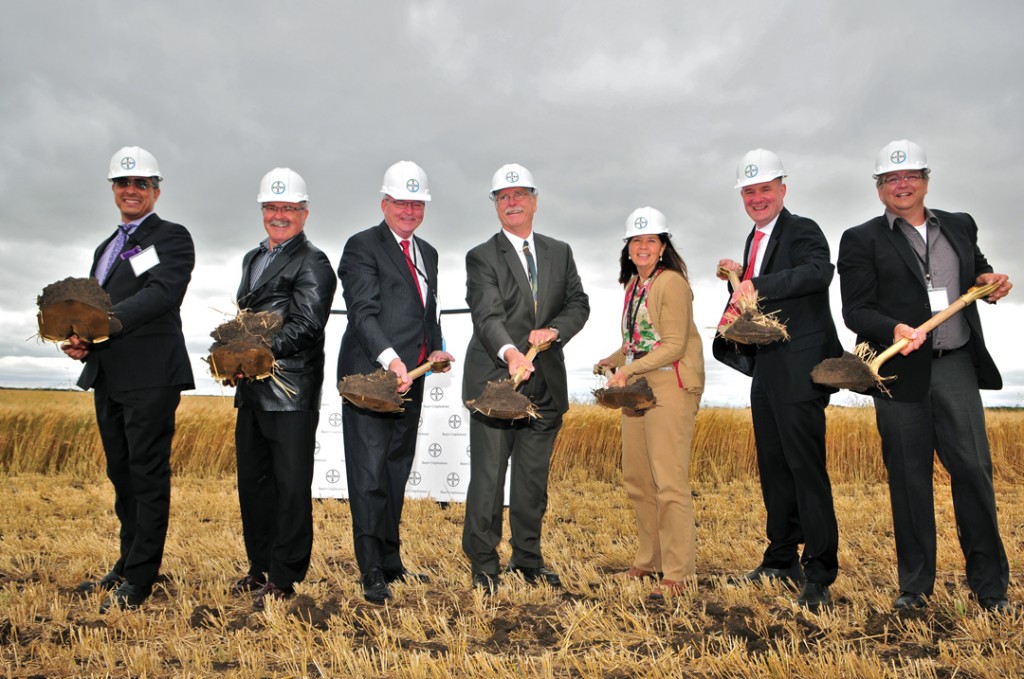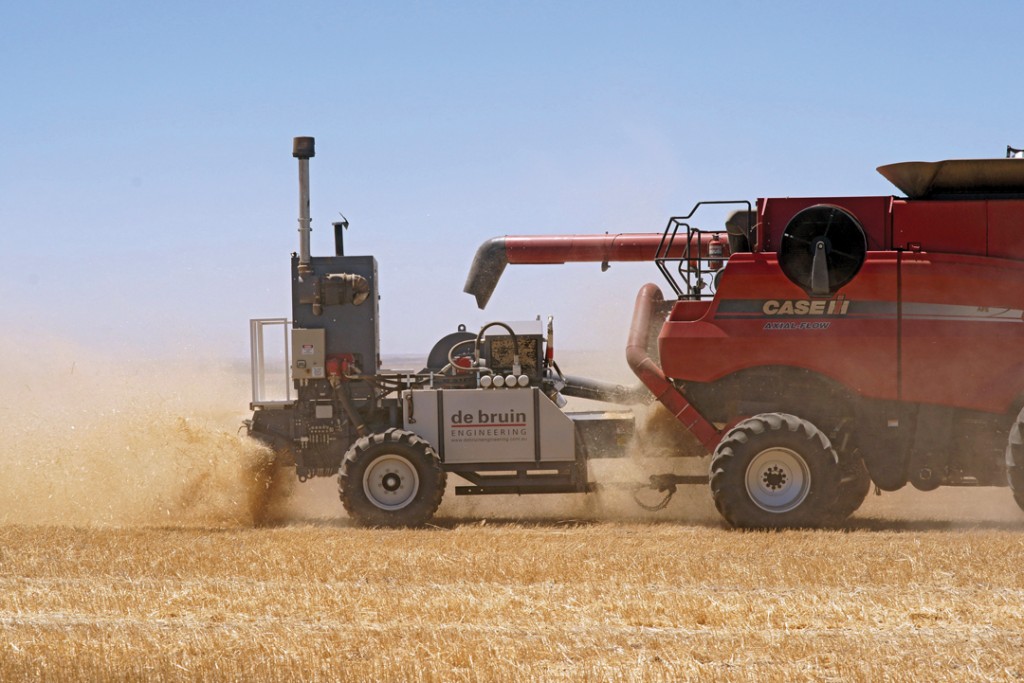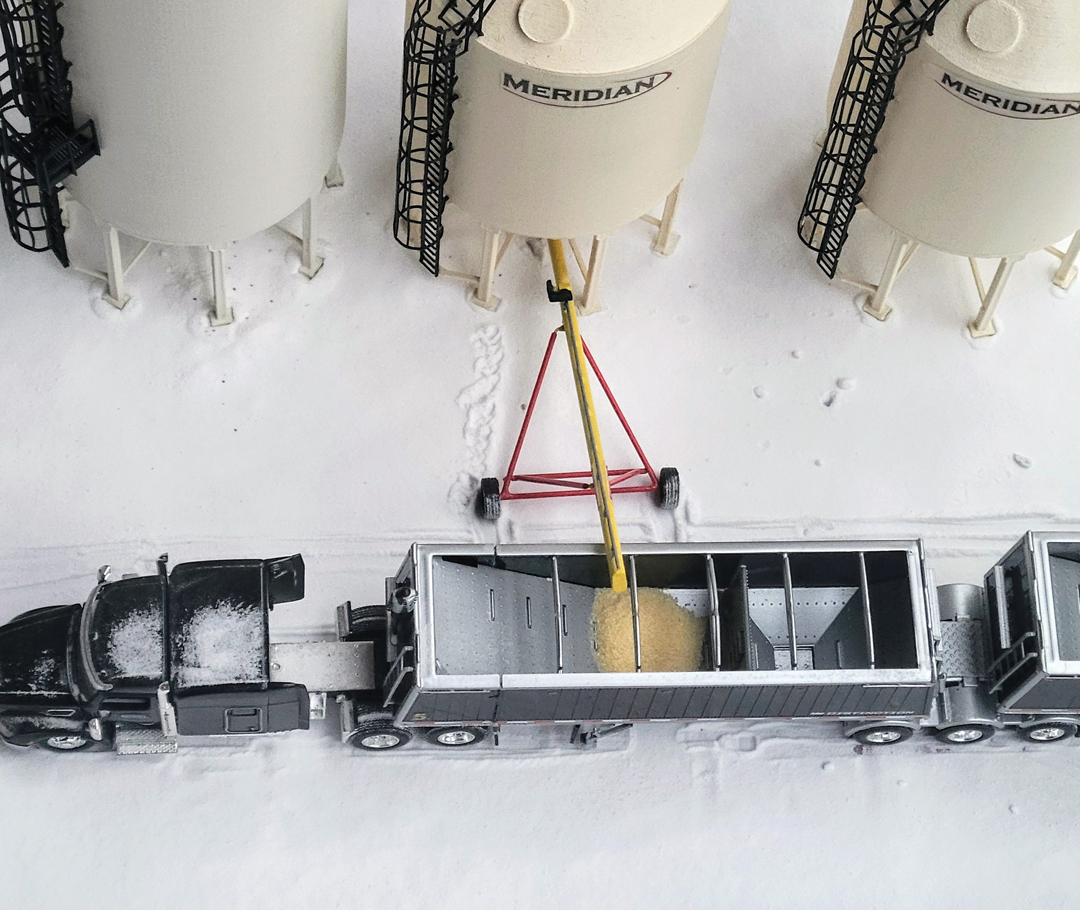THE FARM GATE
BY JEREMY SIMES
A CENTURY OF SUCCESS
John Bocock believes the University of Alberta’s Faculty of Agricultural, Life and Environmental Sciences (ALES) has seen a healthy, progressive change over the last century.
“Back in my day, we were really thinking about how much fertilizer we should use to get good yield,” said Bocock, who graduated from what was previously known as the Faculty of Agriculture at the U of A in 1957, and now farms north of St. Albert. “Now, they’re focusing more on the long-term and sustainability. I think it’s great.”
Bocock was among about 500 guests who attended the Myer Horowitz Theatre to celebrate ALES’s 100th anniversary in late October 2014.
“It’s an opportunity to reset a bit,” said Stan Blade, the dean of ALES. “It was a chance to talk about what we are doing, covering everything from the hardcore producer side to nutrition.”
The U of A’s Faculty of Agriculture was established on May 1, 1915. There were only two staff members: the dean and his assistant, who both shaped the minds of the first 16 students who enrolled that year. The faculty has since seen its name change a couple of times, and ALES now boasts 1,600 undergraduate and 500 graduate students enrolled in its various departments.
Ty Faechner, director of member practice at the Alberta Institute of Agrologists, also attended the celebration.
“It was educational, interesting and humorous,” said Faechner, who graduated from the agronomy program at ALES in 1974. “Stan really spelled out his vision. It was great, and people really connected.”
FUTURE FOCUS
A new $35-million national training facility for future CN Rail employees opened this past September in Winnipeg, MB.
The increase in demand for grain and energy products prompted the investment, said Mark Hallman, director of communications for CN.
“I think having new employees with standardized training is a really good idea,” said Andrew Weir, CN’s on-the-job trainer coordinator in Sarnia, ON, before the facility opened.
In learning laboratories, the facility provides hands-on experience for up to 400 workers, ranging from car mechanics to signal maintainers. It takes seven weeks for a new employee to complete CN’s conductor program, and three weeks to complete its engineer program. The facility also includes outdoor labs with rolling stock and other equipment for field training.
The training campus will enhance the company’s railroader training programs, providing a strong safety culture for the company’s new employees, and reinforce that culture for current employees who are upgrading their skills, according to CN.
Winnipeg was an ideal spot for the new facility, Hallman said.
“The city is central to our operations. It’s a hub that funnels a lot of our traffic, from east to west and north to south.”
The new Winnipeg training centre is also “a symbol of the key role that Winnipeg and Manitoba play in CN’s network,” said CN CEO Claude Mongeau.
The facility is part of CN’s workforce renewal plan, which saw the hiring of more than 3,000 employees by the end of 2014.
As evidence of CN’s growth, the company opened a similar facility in Homewood, Illinois, in October, in a location that is geographically central to American operations. CN also spent $70 million this past year on a program upgrading its main corridor between Edmonton and Winnipeg. Another $30 million was spent to improve CN’s Prairie North Line, a second line that runs parallel to the company’s main corridor.
WHEAT GOES PRIVATE
As global market access for agriculture and agri-food amplifies, Marcus Weidler hopes a new wheat breeding facility will boost Canada’s competitive edge.
“It’s critical we provide producers with crops that are stable with high yield in today’s competitive global market,” said Weidler, vice president of seeds operations at Calgary-based Bayer CropScience Canada.
Early September 2014 marked the groundbreaking of Bayer’s new Wheat Breeding Centre near Pike Lake, SK.
The site was chosen “solely based on the soil” in the region, Weidler said.
“Nothing is more crucial than having the right nursing conditions for the wheat,” he explained, adding that Bayer’s team finalized the deal after taking numerous soil samples and comparing multiple sites for two years.
He said the site is a perfect fit because all types of wheat are represented in Saskatchewan.
The Wheat Breeding Centre is a continuation of Bayer’s ongoing ag investment, following the expansion of its Canola Breeding Centre of Innovation in 2009, according to Weidler.
“We’ve seen canola grow in places that we never thought possible,” he said. “That’s because different breeds were made. So we thought, ‘Why not do that with wheat?’”
Once the facility is built, about 15 to 20 full-time and seasonal staff members will work on everything from planting to genetic analysis.
In particular, technicians will look at breeding the best germplasm, or genetic variability, in the wheat. The more variable the wheat variety’s genetics, the likelier a better crop will be produced, said Weidler.
“Developing a certain type of wheat has to have high yield and yield stability,” he explained.
Once a new wheat variety is developed and approved, Bayer will partner with other companies that will produce seeds under tight quality control. The seeds will then go to market for farmers.
The groundbreaking of the new facility marks the possibility of wheat becoming a “big player” in the agricultural market, said Saskatchewan Agriculture Minister Lyle Stewart.
“My hope is that Bayer will be at the forefront,” said Stewart. “We are proud to have this facility, and I hope the best things come from it.
“The days of government funding all research are long gone. Government should do some research while the private sector does some as well. We would like to see more private companies do research—taxpayers shouldn’t have to completely foot the bill.”
Bill Gehl, chair of the Saskatchewan Wheat Development Commission, also noted the shift in the landscape of the wheat breeding industry, where private companies can now share the pie with the government that once funded all research.
“I don’t think we have to jump up and down and be afraid, nor jump up and down and say, ‘Hooray,’” said Gehl, who also farms near Regina, SK. “I’d like to hope plant breeding worldwide is a shared vision. The more wheat breeding that’s done in Western Canada, the better—whether that’s through the government or private companies. We just want to make sure we maximize farmers’ net returns on investments.”
As the landscape changes, Levi Wood hopes the facility will be the first of many.
“I think getting facilities like this is great,” said Wood, president of the Western Canadian Wheat Growers Association, who farms near Pense, SK. “I hope we get a bunch of varieties out of it to maintain competitiveness with other markets. Research like this will ultimately create varieties with higher yields and better germplasm that can handle potential hazards.”
Completion of Bayer’s new facility is slated for July 2015.
HAPPY HARVEST
Breanne Tidemann hopes a new method of controlling herbicide-resistant weeds from Australia takes off in Canada before the problem becomes severe.
The method requires the use of the $120,000 Harrington Seed Destructor (HSD), a tow-behind machine attached to a combine that collects weeds and grinds their seeds at harvest. Tests in Australia have shown the HSD is able to crush 92 to 98 per cent of weed seeds.
“We’re hoping Canadian producers can use the Harrington Seed Destructor to manage weeds before herbicide-resistance gets really bad,” said Tidemann, a University of Alberta graduate student. “The machine would be an add-on to conventional herbicide methods.”
As part of her PhD research, Tidemann is working with a team of researchers at Agriculture and Agri-Food Canada (AAFC) looking at the seed retention of weed species like volunteer canola, wild oats and cleavers.
Researchers in Western Canada will test the machine in fall 2015 after the data on weed-seed retention is complete, Tidemann said.
“It looks like cleavers will be a good fit because they hold seeds long into harvest, and produce high in the canopy. Volunteer canola is a good target. But wild oats seem to lose their seeds early on before harvest.”
Despite these first findings, more trials need to be done to be sure the machine is a good match for Canadian weeds, Tidemann added.
Positive Australian results prompted Canadian researchers to take a closer look.
In fact, 70 per cent of Western Australian growers are using a harvest weed-seed system due to high rates of herbicide resistance, according to Michael Walsh of the University of Western Australia, who has worked closely on HSD trials.
High rates of herbicide resistance developed due to the predominant use of conservation cropping systems and the complete reliance on herbicides for weed control, which delivered high frequencies of herbicide resistance, Walsh explained.
“Herbicide resistance in the dominant weed species is expanding at a dramatic rate,” he said. “There is a need to add additional weed control options into weed management programs.”
Herbicide-resistant weeds affect 40 per cent of cropland in Canada, according to estimates from Bob Blackshaw, weed scientist at AAFC. And herbicide use is a major method to tackle weed populations, he added.
“I think it’s important to have new methods that control weed seeds,” he said. “We don’t do much to get rid of weed seeds at harvest, although some farmers use pre-harvest herbicide applications.”
Methods like tillage, crop rotation and growing crops that “choke” weeds are instrumental when controlling weed populations at other times of the year, Blackshaw added.
Canadian farmers have largely balked at the machine’s price tag, but Blackshaw said the weed-population in Canada has worsened over the last 25 years, meaning new methods may need to be implemented.
“In the late ’80s and early ’90s, we’d see wild oats in 10 per cent of the fields we’d look at. Now, that rate is at 50 per cent,” Blackshaw explained. “Every year, wild oat populations get a bit worse, but we still have some time to establish other methods of controlling weed seeds on the Prairies.
“We haven’t seen a new herbicide come to the market in the last 15 to 20 years, and we can’t continue to rely on new herbicides to solve the problem. We have to see what other methods are available.”
Tidemann said it’s incredibly important to ensure farmers can continue to produce high-quality, high-yielding crops.
“We’re not in a state right now where adoption of harvest weed-seed control practices are absolutely necessary, but we don’t want to get to that point,” she said. “By starting the work now we’ll have the answers for when producers need them to aid in the management of their weeds.”
PARTNERSHIP PLANS TO IMPROVE WHEAT-BREEDING EFFICIENCY
The Canadian Wheat Alliance (CWA) has added another project to its list.
In mid-October, the CWA partnered with Syngenta and KWS to cut the cost and time it takes to develop new wheat varieties. The four-year initiative will cost $2.5 million.
“This partnership is very important,” said Faouzi Bekkaoui, executive director of the wheat improvement flagship program at the National Research Council Canada in Saskatoon. “Farmers and breeders have challenges. For example, crop diseases develop quickly. Through the partnership, producers will get varieties quicker than they normally would, which will let them access crops that are more sustainable against disease sooner.”
“We strive to improve the yield, production, sustainability and profitability of Canadian wheat for the benefit of our farmers and our economy.”
The current methods used to develop doubled haploid wheat plants are costly and inefficient, said Bekkaoui.
Improving existing methods is expected to cut two to four years from the breeding cycle, meaning potential varieties will be able to get to market more quickly, ultimately benefitting producers, he explained.
Once the new methods are developed, all partners will implement the technology into their own programs.
That will conclusively optimize breeding costs, said Darcy Pawlik, the North American head of Syngenta’s cereal portfolio.
“The partnership is unique, where we have private and public institutions collaborating, but we are also bringing in producer dollars,” he said. “Once the project is done, all of the partners now have a tool their breeders can use. It’s cheaper for the partners and better because all of them can then use the doubled haploid technology to produce varieties that farmers are looking for.”




![ALES-100-Panel[4]](https://grainswest.com/wp-content/uploads/2014/12/ALES-100-Panel4-1024x954.jpg)




Comments